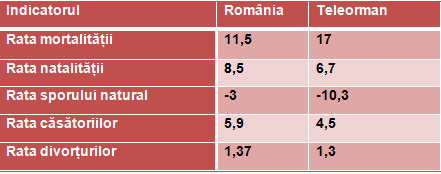 Romania’s population declined between March 2016 – February 2017 by 74,050 people. The number is comparable to the population of a middle-sized city, a capital of a county like Alba Iulia, for instance (74,085 inhabitants).
Romania’s population declined between March 2016 – February 2017 by 74,050 people. The number is comparable to the population of a middle-sized city, a capital of a county like Alba Iulia, for instance (74,085 inhabitants).
Romania’s annual natural growth went, for the first time, below the threshold of -70,000 people: in the 12 months between the beginning of March last year and the end of February this year, only 188,565 children were born and 262,615 Romanians died.
The data of the National Institute of Statistics (INS) are provisional, so figures might look a little better when the final results are announced for this interval. We mention that provisional reports for the „natural movement of the population” category contain under-declarations of births.
The previous record was in 2014, when only 195,612 children were born (revised data), which represents only 62.15% of all newborns in 1990 (314,746).
January of this year marked the worst negative growth in Romania’s history, minus 13,704.
In fact, December and February also oscillated very closely to the previous negative record, in March 2015, when the natural growth was -9,985 people. That means the situation for 2017, if the trend maintains, could bring a negative natural growth far above last year.
*
- Natural growth of population
*
It will be interesting to see if the measure (applied since August 2016) to remove the threshold set for allowances paid to the parent who stops working to raise her child up to two years of age will reverse this trend.
County with most accelerated population decrease – Teleorman
The natural population growth rate (measures the difference between mortality and birth rates) was -2.8 per 1,000 inhabitants in 2015.
Lower rates are recorded in poor counties, but this is not a generally valid rule – there are counties with low GDP and incomes where the growth is much better than the national level, as there are relatively rich counties with a significant decrease and far below the national average.
Vaslui, for instance, is one of the poorest counties and has a natural growth of -1.3 per thousand inhabitants. This rate is approximately equal to the one in Timis (-1.1), an incomparably richer county.
Population decline is relatively consistent with the poverty in the south of the country:
*
- Rate of population natural growth
*
Teleorman is by far noticeable as having the lowest rate of natural growth, close to -10, more than three times the value registered at the national level.
The county that the PSD’s current leader, Liviu Dragnea, has been leading for many years now has been a champion in this area since the mid-1990s. The head of the Social Democrats was the prefect of Teleorman between 1996 and 2000, then chairman of the county council for three mandates until 2012.
The Deputy Executive Director of the Teleorman County Statistics Department (DJS), Gabriel Cringeneanu, explained to cursdeguvernare.ro that this situation has been periodically presented to the local authorities, including at the prefectural college organized last month.
But he does not know whether these authorities have started any analysis to detail the findings of DJS Teleorman.
Demographic situation of the county, compared to the average national levels in 2016:
*
- Indicator
- Mortality rate
- Birth rate
- Population natural growth
- Marriage rate
- Divorce rate
*
Highest mortality rate
Population natural growth, according to an analysis of DJS Teleorman, was determined by the small level of births (birth rate ranks 39th in the country) and the very high rate of deaths to the population (the highest mortality rate).
Factors that affected the number of births:
- The increase over the last 40 years of the average age at which a woman gives birth to her first child, from 20 to 27-28 years
- Lack of jobs causing a lack of means to support a child
- Decrease in female populations of childbearing age (15-49 years)
Factors that have affected the number of deaths:
- aging population – the share of the population aged 65 and over was 20% in 2016, compared to 15% in 1992 and 14%, the ratio of this age group at the national level.
- the high percentage of the rural population, where living conditions are more precarious than in urban areas – in Teleorman county, the share of the rural population was 64% in 2016, compared to 44% at national level.
Methodological explanations from INS regarding these demographic indicators:
- After 2012, these indicators take into account the persons who are permanently or ordinarily resident in Romania
- The domicile of a person is at the address where she declares that she has the main residence, mentioned in the identity document (CI, BI), as evidenced by the state administrative institutions
- The person’s habitual residence or the period and/or the reason for absence from home are not taken into account.












